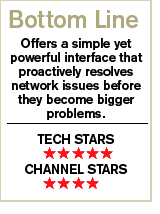Review: Management With A Bite

A management system from U.K.-based HoundDog Technologies offers solution providers a simple and powerful tool to manage several customers' networks at once. The server monitoring system, dubbed HoundDog, is specifically designed for IT support companies and MSPs. HoundDog monitors all "live" IT, detecting and alerting a wide variety of issues, including those relating to disk space, TCP ports, failed disks and Web site outages. HoundDog can track hardware and software assets, generate inventory reports and track software licenses. HoundDog provides server monitoring and client reporting using a small software agent called Advanced Monitoring Agent to collect network data.
The system is deceptively simple. Software agents installed on servers in each location are configured to run various monitoring tests, or checks, on the network. The agent communicates the results back to the central servers located at HoundDog Technologies via an encrypted SSL connection. Data collected by the agent is presented in a dashboard that is accessed by a Web browser. There are no appliances to configure or software packages to tweak. The company promises to be up and running monitoring a new customer's network within 10 minutes. CRN Test Center engineers set up test networks in two different locations. In the first location, there were three laptops, three Linux servers and two desktops running Microsoft Windows XP, while the second location had three Windows desktops. The agent software was installed on one computer in each location, and between the two computers, 19 checks were configured. The checks included a ping test, which pinged every computer on the network every 15 minutes and sent an alert if the computer was down; physical disk health; disk space monitor, which sent an alert as soon as available space dropped below 100 Mbytes; TCP/IP services, to ensure the ports that should be open (80 for HTTP) were open and ports that shouldn't be (21 for FTP) weren't; Windows services, which sent an alert if a service's run-status changes; antivirus updates, which sent an alert if the virus definitions were out of date; and Web site scan, which sent an alert if a particular test string appeared or disappeared from the site.
The dialog boxes make it easy to configure the checks. Some tests require an IP address and a failure threshold—a numeric value that determines when the alert will be sent. Other tests, such as the ones that check on status, can send an alert either on failure or on success. The alerts can appear on the dashboard and can be sent to an e-mail address.
The monitoring agent can be installed on Windows NT 4.0 or higher server operating systems, including Windows 2003, and on desktops running Windows 2000, Windows XP and Vista. While HoundDog can monitor networks with Linux and Apple Macintosh servers, the software cannot be installed on those machines at this time.
Next: The Bottom Line The lightweight agent software needs only 5 Mbytes of disk space. It takes up 5 Mbytes of memory when running its checks, which is negligible compared to competitive systems.
The HoundDog dashboard is organized by sites. A site can refer to a physical location, as it was in the Test Center environment, or it can be a logical construct, with some machines within a network grouped together. For example, all the computers that belong to the accounting department can be grouped together as a site in HoundDog's view, regardless of where the machines are actually located. The dashboard is a central repository, displaying information about all the customers and their sites in one location.
Sites based on a logical grouping are very helpful for asset tracking and workstation monitoring. Domains and IP address ranges can be specified in the agent for asset tracking and workstation monitoring.

HoundDog offers several options for flexible dashboard viewing. WallChart provides a simplified view of the dashboard that refreshes continuously, which many companies project onto a large screen as part of a centralized command center. There's also MiniDash, designed for cell phones and PDAs.
Solution providers can brand every aspect of the application as their own if they choose to do so. This includes the dashboard, MiniDash, reports and the Advanced Monitoring Agent. As far as customers are concerned, the application comes directly from their solution provider. A simple DNS entry redirects the HoundDog dashboard to the solution provider's site to further the brand.
HoundDog offers multiple revenue opportunities. It is a great fit for solution providers offering network management services for SMB customers. Partners can also resell the solution to customers who want to manage their own networks. HoundDog claims that solution providers can expect up to 60 percent margins on services.
With HoundDog, customers pay monthly only for services used. There are no up-front license, maintenance or upgrade fees. The monthly service charge is based on the network checks being used and a flat $2.95 fee for the dashboard. Many of the checks cost only a dollar per month, although the Windows Service Check costs $3.45. A server checking only for antivirus and disk space would cost $7.40 per month, and the solution provider can offer the service for as low as $10 per month.
HoundDog reports help identify sales opportunities, highlighting new devices on the network and tracking software licenses. Monthly client reports also identify recurring problems that can lead to other revenue.
HoundDog treats the network holistically, where the system looks at servers, workstations, the cables connecting everything together to form a network and all the data. Solution providers can use the product in a multitude of ways, but the end result is always the same: the customer's network is up and running.